
The sequelae of Smartlipo or laser liposuction can be readily seen in the collection canister or what is known as the aspirate. There are, however, many misconceptions of what exactly is in the aspirate. When a patient asks how much fat was removed or the plastic surgeon notes in the chart how much fat was removed, this really refers to the aspirate. The aspirate is essentially comprised of three main components, fat, blood, and tumescent fluid. Remember that all liposuction is done with the initial infiltration of a tumescent fluid which provides pain and bleeding control. So some of that infiltration fluid is what is being sucked out. If one waits long enough, the aspirate will traditionally settle out into two main layers, fluid (including blood) at the bottom and fat (which is lighter than water) which floats on top. The ratio between the two varies with each patient but is generally 10% to 30% fluid and 70% to 90% actual fat. So if you had one liter of fat aspirate removed, the actual amount of true fat is a percent of that total.
The aspirate of Smartlipo actually shows three distinct layers, fluid, more solid fat, and fat oil on top. This can clearly be seen in the canister. This demonstrates that a portion of the fat removed has been liquefied while more solid or particulated fat has also been suctioned. The ratio between particulated fat and fat oil will vary depending upon how much time was spent using the laser to build up the heat in the area. The oil ratio increases based on time spent lasering. The goal is not to have a complete oil aspirate as that would indicate that too much heat has been applied to the area. While no exact amount of time or oil ratio has been established as of yet, it is important to see some oil layering or too little time was spent lasering and the benefits of Smartlipo will not really be seen.
This liquefaction of fat by laser liposuction also accounts for why there is persistent drainage from the entrance sites for a few days after surgery. The oil (and fluid) continues to drain out which is actually a good thing. This means that one will have less swelling as the body will not need to absorb the oil from the fat cells that have been ‘melted down’.
Dr. Barry Eppley
Indianapolis, Indiana


